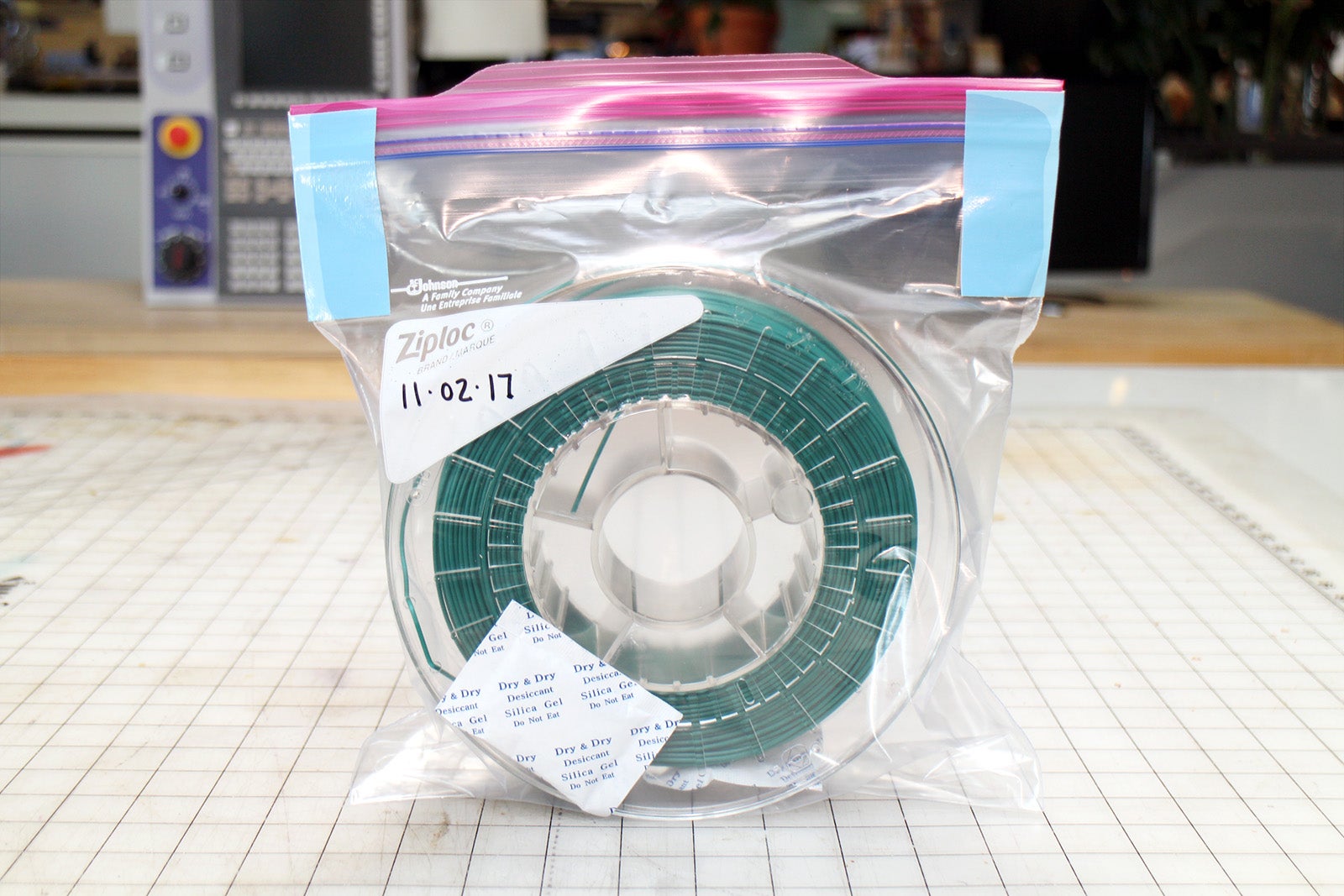How to Store 3D Printing Filament
by Paige Russell in Workshop > 3D Printing
53312 Views, 225 Favorites, 0 Comments
How to Store 3D Printing Filament

Whether you're a hobby 3D printer or someone who does it professionally, the most important thing to know – other than how to work the machine of course – is how to properly protect and store your 3D printing filament.
Filament that hasn't been properly stored absorbs moisture from the air, which over (not very much) time degrades its quality, causing failed prints, sputtering (as the stored moisture is heated going through the machine), and nozzle blockages (the WORST!).
In this instructable, I'm going to show you an inexpensive solution for this problem that will save you time (fewer nozzle cleanings!) and money, by protecting your filament investment (that stuff ain't cheap!).
Ok, let's go save a filament's day!
Supplies
The list of things you need is nicely short – AND as I said, inexpensive.

- Bag of 20 - 30* silica gel desiccant packs ($7.99 - 10.99)
- Box of good quality gallon plastic storage bags ($9.99)
- Permanent marker ($0.93)
- Duct tape ($5.69)
NOTE: The silica packs are reusable many times over (by drying them out in the oven and re-activating them) and the plastic bags are durable and also reusable, so you can protect a lifetime of filament rolls with a very minimal up front investment.

*Count on using 2 silica gel packs per roll of filament – so the number of rolls you have to store will determine how many gel packs you need. They come in 20 to 200 pack bags.
NOTE: If you have more than 10-20 rolls of filament to store on a regular basis, you may want to consider investing in, or making, a humidity controlled cabinet.
What we'll be making is a simple, dehumidified environment for each roll to live in. One plastic bag and two silica packs per roll is all that's needed to give the filament a very healthy, long life!
How to Save a Damaged Filament Roll
If you have any filament that has already absorbed too much moisture and is producing poor quality prints or jamming up your nozzle, DON'T DESPAIR! There is an easy fix for getting that filament back on 'dry land' and to being totally usable again.
How to Dry ABS and Other Filament
- Preheat the oven to 140°F - 160°F (NOT CELSIUS)
- Place the wet, damaged roll of filament in the oven for 5 hours
How to Dry PLA Filament
- Preheat the oven to 120°F (NOT CELSIUS)
- Place the wet, damaged roll of filament in the oven for 7 hours
For all types of filament, leave the oven door cracked open a bit and turn on the overhead fan.
This is like hitting the restart button on any damaged filament. Once it's dried out, continue with the following storage steps to prevent it from getting 'wet' again.
*To learn more about the science behind why and how filament gets wet – and to see photos of what prints made from healthy and damaged filament look like, check out this great article from the Matterhackers site.
Date the Roll & Bag


The rule of 'lifespan' thumb for a roll of PLA or ABS filament is 12 months (check with the manufacturer for other types). This is why I like to mark my rolls with the calendar date it came in the mail. *You can also date its storage bag if you'd like.*
It's safe to assume that at least 1 month (maybe 2) has passed since the roll was manufactured – due to transport and storage times as it changed hands from manufacturer to fulfillment house to you, so I usually try to finish each roll within 10 months of those written dates.
Reinforce the Bags


- Cut two 3" pieces of duct tape.
- Stick one (in half) to each top side of a one gallon plastic storage bag. (like pictured above)

This is important to do because the sides of the bags can easily split over time as you take the filament roll in and out. This reinforces those weak points and gives the bag a very long life.

Ta da!
Load the Bags

- Next, load a roll of filament into the bag.

- Add two silica gel packs to the bag.

- Seal the bag, making sure that it's properly closed the entire way.
TIP: Stop an inch short of sealing it and press out as much air as you can before sealing it all the way!


The only thing left to do is to stack your safely stored rolls in their designated home!
NOTE: If you're trying to make tall stacks, the bags can make this hard due to their 'slip and slide'iness. An easy fix for this is to place a 1/2 or 1/4 sheet of regular printer paper in between each bagged roll. Slip problem solved!
And that's it! Like I said, it's a VERY simple solution to a potentially expensive problem.
There are of course other ways of protecting your rolls that work well, like vacuum sealed bags and plastic bins with larger desiccant packs, but I find both of those solutions cumbersome, as the vacuum machine takes up more space and requires an extra step each time you use a roll, and the bin is larger and harder to hide away.
In my opinion, individual bags is where it's at! How do you feel about it? Please feel free to weigh in in the comments section below.
Happy making everyone!
Paige :D